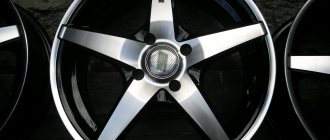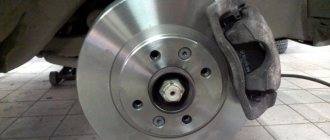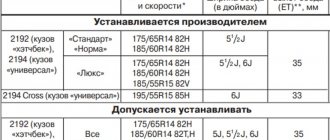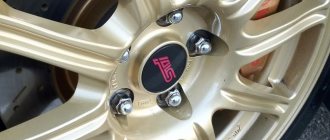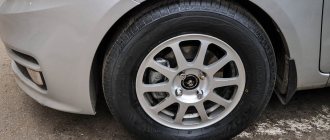Disk mass limit for products made from different alloys, using different methods and having different designs.
Data are expressed in pounds (lib).
Disc weight 13×4.5
| Discs | m (kg) | m(lib) | Parameter | By brand |
| 13×4.5 | 4.72 (kg) | 10.41 (lib) | Cast | RS Watanabe EightSpoke F8F |
Caution: due to the fact that different types of disks from different manufacturers can be installed on a car, the above data are averages; actual values for a particular car may differ by 15% in one direction or the other.
A car disk is, in fact, a wheel, its base, which bears the entire weight of the car. Disks are divided into two groups: steel and light alloys.
Steel wheels weigh more, but are much stronger than cast alloy wheels, while forged alloy wheels are stronger than steel wheels and lighter than cast wheels.
For example, for a BMW 7, a steel wheel weighs 9 kg, a cast aluminum wheel weighs 7.8 kg, and a forged aluminum wheel weighs 6.8 kg.
Discs come in different diameters: from 10 to 23 inches. For cars, wheels with a diameter of 13 to 16 inches are mainly used, from 10 to 13 - for ATVs and mopeds, above 16 - for tractors and special equipment.
Weight readings vary depending on the manufacturer and width, the table shows the average values:
| Disc diameter | Weight of one disc in kilograms |
| Steel disc (stamped) | |
| 12 inches (R12) | 4,5 |
| 13 inches (R13) | 5,2 |
| 14 inches (R14) | 6,3 |
| 15 inches (R15) | 7,4 |
| 16 inches (R16) | 8,5 |
| 17 inches (R17) | 12,1 |
| Cast light alloy | |
| 10 inches (R10) | 2,5 |
| 11 inches (R11) | 3,3 |
| 12 inches (R12) | 3,9 |
| 13 inches (R13) | 4,5 |
| 14 inches (R14) | 5,6 |
| 15 inches (R15) | 6,9 |
| 16 inches (R16) | 7,8 |
| 17 inches (R17) | 8,5 |
| 18 inches (R18) | 9,4 |
| 19 inches (R19) | 10,8 |
| Forged alloy | |
| 14 inches (R14) | 4,8 |
| 15 inches (R15) | 5,8 |
| 16 inches (R16) | 6,6 |
| 17 inches (R17) | 7,4 |
| 18 inches (R18) | 8,2 |
| 19 inches (R19) | 9,1 |
| 20 inches (R20) | 10,2 |
From time to time, manufacturers try to break the record for lightness of wheels, since the speed of the car depends on this.
OZ Racing, , R17 6.25, . , 3.
How much do tires weigh on a Kamaz truck?
Considering that in the manufacture of such reliable tires
sole armoring technology is used, they have from 15 to 30 layers of rubber, nylon and metal, their mass is very high. Depending on the brand and structural features, it ranges from 85-110 kg per product.
Interesting materials:
How to customize the backlighting on a Hyperx Alloy Core RGB keyboard? How to customize the backlight on a HyperX keyboard? How to set the backlight on the hail keyboard? How to set the backlight on the Razer keyboard? How to set the backlight on the Smartbuy keyboard? How to adjust the backlight on an MSI motherboard? How to adjust the backlight on an Asus laptop? How to set the weather on the main screen? How to set up channel search on Samsung TV? How to set up a search engine on Google?
see also
Comments 107
NZ SH653(Torus) 6.5Jx16 4Х98 ET32 DIA58.6
Information varies everywhere. So I’m trying to clarify the exact data!
Thank you very much, and especially for your efficiency! And 695 on the KiKa website says 7.3 kg, and 451 6.520 kg. (shop.kolesa-kik.ru/catalo...ross-/37551.html?from=app) At the same time, 695 are written from the replica series and such a weight! Can you tell me what the weight of the factory wheels on the 2022 Grant-Cross is? I called the factory and they can’t tell you, these wheels are not available in the city, so I’m choosing, and you can’t tell me, maybe it’s better to put Slick with studded tires, otherwise She weighs about 10 kg, and where is the best place to buy it?
Stamping of car wheels with a diameter of 14 inches
Stamped car wheels are so called because they are made using the stamping method:
- A plate, the central part, is extruded from a steel blank using a stamping press. The stiffeners are pressed through. Holes for the bolts are drilled. The unnecessary edge is removed. The plate is ready.
- Next, the rim is made. A long sheet of steel is cut. Bends into a cylinder. Welded along the seam, the seam is cut off for smoothness. The cylinder is pressed with a press, the shape of the disk is set. The edges are sanded.
- It would be more correct to call such a disk stamped-welded. Since only the central part itself is stamped, and the rim is obtained by rolling, then the two parts are welded.
- At the end, a hole for the nipple is drilled. Covered with paint.
Among the disadvantages are susceptibility to corrosion, high weight, worse balancing, which means worse road stability and controllability.
Weight of alloy wheels R 12 -R 23
* 27 kg is the maximum weight of wheels with a diameter of 23 inches that was found in our catalogs. The variation in the weight of discs in this diameter is very different. The weight of discs R14, R15 and R16 from different manufacturers and models does not differ as much as that of discs with larger diameters, for example, R17, R18, R19, etc.
All contents of this site are protected by intellectual property legislation (Rospatent, registration certificate No. 2006612529). Installing a hyperlink to site materials is not considered a violation of rights and does not require approval. Legal support of the site - legal..
The difference is in the production technology!
The production technology of cast and forged wheels determined the name of their types. For the manufacture of both the first and second, aluminum alloys with alloying additives are used. The difference lies precisely in the technology, which involves the use of hot die forging, hardening and artificial aging for cast wheels. All these processes allow us to achieve a material structure that will withstand loads well due to its strength and ductility! Thanks to it, forged wheels can be repaired even in situations where cast wheels cannot be restored. Even with strong impacts leading to deformation, forged wheels are not destroyed.
Wheels of the country of the Soviets: factory wheels of VAZ cars
Unlike many other parts, FIAT-124 wheels “took root” on the VAZ-2101 practically unchanged. The disk, 4.5 inches wide and with an offset of 37 mm, had eight ventilation holes of a characteristic oval shape. Since in the first months the plant experienced difficulties with components, on the “kopecks” of the period 1970-1974. one could also find other disks - with sixteen round holes, around which peculiar stampings were made.
To protect the mounting bolts and wheel bearing, the central part of the rim was covered with a beautiful chrome cap - exactly the same as on a Fiat, only without the inscription with the name of the car in the center. In order for it to stay on the disk, special “ears” were provided, and such a cap could be removed thanks to its spring properties.
In the early years, the wheels were painted silver, but later on all cars of the 2101 family only wheels with oval holes, painted in a gray-white shade, were installed.
Already in 1991, wheels of type 2101 became half an inch wider and received humps - special protrusions on the shelves for a tight fit of tubeless tires. At the same time, the “penny” wheels got rid of the “lugs” for the hubcaps.
Those who are currently engaged in restoration should take into account that, according to the offset parameters, it is permissible to mount only 2101 or 2108 wheels.
2103/2106
“Treshka” received new wheels. In appearance, they were very similar to the “Fiat” ones already found on the early VAZ-2101: the same sixteen round holes, but the rim width increased to five inches, and the offset, on the contrary, decreased to 29 mm. Such a disc was installed on “three-ruble” and “six” cars, and on cars of the third model a cap of type 2101 was used, and on the “six” there was an original one. You can distinguish it by the black round overlay in the center.
True, other wheels were planned for the “six,” the angular design of which echoed the appearance of the then newfangled light-alloy (aluminum, as they were called) wheels. However, for technological reasons, such a disc did not go into production.
Since 1991, “penny” caps were also found on the new “sixes,” and since 1995, type 2103 wheels lost the protrusions for fastening the caps and became the only conveyor disks for all Zhigulis. So that such a disc could be installed on the “five” and “seven” with a chrome-plated hub cap, the diameter of the central hole of the disc was increased to 60.5 mm. It was on such “three-wheel drives” without ears that the classic Zhiguli became part of history.
The 16-inch Niva wheel, 5 inches wide, is similar in mounting parameters to GAZ and UAZ wheels (five bolts). The characteristic disc design with twelve round holes and a large offset (58 mm) appeared already on early prototypes, and it “accompanies” the old Niva throughout its production line life! Over time, the disc received bumps so that the wheels could be used in a tubeless version.
Often, Soviet Niva owners tried to make them more suitable for driving on asphalt by installing “Volgov” wheels and discs. But at the same time, due to the unacceptably small offset, the wheels stuck out, which led to a violation of the suspension kinematics.
2105/2107
Even at the prototype stage, the “five” had original wheels, the design of which was reminiscent of the “six” prototypes: angular lines, rectangular ventilation holes, the absence of a central cap. Similar solutions were used at that time on many European-made cars - for example, VW and Audi.
On the way to the conveyor, the shape of the hub became somewhat simpler to please the technologists, but still such wheels were noticeably different from the previous “Zhiguli” ones, although in terms of parameters the “five-wheel” disk with five oval holes completely duplicated the 2103 wheel.
The "seven" had its own wheels - similar in design to the VAZ-2105 wheel, but with four ventilation holes instead of five. However, only a small batch of wheels with catalog number 2107-3101015 was produced, and all cars of this family (2105/2104/2107) until 1995 rolled off the assembly line on “five” wheels. By the way, wheels from 2105 were also installed on some modifications of the “six” - for example, on the VAZ-21065.
The first front-wheel drive VAZ received original wheels of its own design with an offset of 40 mm, uncharacteristic for a Lada. The so-called early wheels were distinguished by a narrower rim (4.5J) and ventilation holes - they were slightly larger and “sharper” than on cars since 1989. Today, “early” wheels are a kind of artifact, which are hunted by connoisseurs of “correct” » Samara of the Soviet period. Later wheels also featured a rim width that was increased to five inches, and the holes themselves became slightly smaller. Like the latest Zhiguli models, the G8 disc had no protrusions for the caps, and its mounting bolts remained open.
The plant allowed the replacement of a disk with catalog number 2108-3101015 only with a “penny” one, since when using disks from other “classic” models with a shorter offset, the load on the wheel bearings sharply increased and the kinematics of the suspension were disrupted due to a decrease in the running-in arm.
The transition to a 12-inch tire also required an original wheel. Part number 1111-3101015 was only 4 inches wide and had a 40mm offset. Another uncharacteristic solution is a three-bolt mount instead of the classic 4x98. It is interesting that early prototypes had six oval holes in the discs, but a “simpler” version went into production - with 12 round holes, which in design resembled a scale copy of the Niva wheel.
One size, but not one design
So, practically the only standard size of Soviet-made VAZ passenger cars was thirteen inches. Interesting fact: stamped wheels with the 2108 wheel design are still “in service”: modern Lada models are equipped with them as standard. In the following materials we will look at what tires VAZs of that time were equipped with and will touch upon an even more interesting topic: alloy wheels of the USSR.
What wheels were installed on different bodies and configurations?
When selecting new wheels for any car, including the domestic VAZ-2107, it is necessary to take into account a number of factors specific to this particular model. Traditionally, most cars that rolled off the Volzhsky Automobile Plant assembly line had the most budget-friendly wheel options. The VAZ-2107 was equipped with 13-inch stamped steel elements with standard tires in size 175/70R13.
Starting from 1982 until the end of mass production in 2012, the “seven” was produced in 13 modifications. One of them, namely the VAZ-21077, was developed specifically for export to the UK. In this version, more expensive, alloy wheel versions were installed on it.
Knowing the basic technical parameters of a wheel rim, you can determine its compatibility with a specific car model. In addition to the diameter, you need to take into account such indicators as:
- Rim width.
- PCD – diagram for drilling mounting holes (bolt pattern).
- ET – disc ejection.
- DIA is the diameter of the central hole.
As for the bolt pattern and the central hole, everything here is traditional for the old Tolyatti models. These indicators are strictly tied to the parameters of the hub. In numerical terms, they look like this: 4x98 mm and 58.5 mm, respectively: 4 is the number of fastening points, 98 mm is the distance between the centers of opposite mounting holes, 58.5 mm is the diameter of the hole located in the center of the disk.
Rim width is measured in inches. In the VAZ-2107 this indicator is equal to the values 5 and 5.5. Knowing the width of the rim, you can understand how wide the tire should be. In the marking this value is written as follows: 5J and 5.5J.
The offset is the segment between the imaginary plane dividing the rim into 2 equal-width rings and the docking area of the car's hub. In the marking, these are the letters “ET” and the numerical value is indicated in millimeters. Standard VAZ-2107 wheels have an offset of ET29.
Full coincidence of the central hole of the disk with the corresponding parameter of the hub helps to accurately center the disk during installation, which has a positive effect on the service life of the tires and eliminates wheel runout when driving.
2103-2106
The third model of the Zhiguli was decorated with updated wheels. They looked very much like Italian ones. However, their width has become larger (5 inches), and the offset, on the contrary, has decreased (29 mm). The product was installed on the third and sixth models.
But the VAZ 2106 had its own original wheel; it could be distinguished by a black lining fixed in the middle.
In 1995, designs began to be produced that did not have fastenings for caps. It was she who began to be installed on all models of the domestic VAZ.
To install disks on the VAZ 2107 and VAZ 21053, the size of the central hole was specially increased. Now its diameter has become 60.5 millimeters.
How do they look
Almost everyone can imagine what stamped wheels look like, since stampings are currently the most common car wheels - about 70 percent of cars use them. And also almost all commercial vehicles are equipped with stamps.
Many consider the appearance of stamped wheels to be their main disadvantage. Indeed, they do not have such a variety of designs as their forged and cast counterparts, and they are all similar to each other. Only the colors can differ radically.
Life time
The level of wear resistance of stamped discs is strongly influenced by two indicators:
- disc deformation while driving;
- corrosion.
Painted stampings
The second important factor that reduces the service life of stamps is that they rust. Accordingly, if the disk becomes very rusty, it will no longer be usable. Therefore, it is important to store car wheels in dry, indoor areas. Painting can also slightly prevent inevitable corrosion.
Front-wheel drive VAZ cars
They received new wheels that differ in their original design and offset size (40 mm). In the first models, the rim became much narrower (4.5J). The diameter of the ventilation holes is slightly larger. Nowadays, such wheels have become an “artifact”. Collectors of old Zhiguli cars buy them with pleasure.
The front-wheel drive VAZ 2108 was equipped with its own disk, which could only be replaced with an analogue from the VAZ 2101. The fact is that on other models the design had a smaller offset.
As a result, the hub bearings began to experience heavy loads. The running-in shoulder became smaller, the kinematics of the machine were disrupted, and the bearings simply fell apart.
From all of the above, only one conclusion can be drawn: all VAZ cars were produced with R13. However, even today, “stamping”, having the design of VAZ 2108 wheels, is installed on modern Zhiguli.
Parameters of standard nuts and bolts
M12x1.25 bolts were used as fasteners in the VAZ-2107. As a replacement, you can use studs with nuts. Both bolts and nuts have a pressure shaped surface under their heads. The choice of nuts and bolts according to the shape of the clamping surface is made in accordance with the shape of the seat of the mounting points on the disk being installed. The use of fasteners that do not comply with this requirement is unacceptable.
The material of alloy wheels is much softer than steel. For this reason, an increase in the contact area with the clamping surface of the fastener is required. But, even if everything is selected and tightened correctly, during the first time of operation you should regularly tighten the bolts or nuts until the metal has completely settled and compacted in the drilling areas.
?
, , , , . : .
, , .
, W 7 9 , – 7.8 , – 6.8 .
: 10 23 . 13 16 , 10 13 , 16 .
, :
| () | |
| 12 (R12) | 4,5 |
| 13 (R13) | 5,2 |
| 14 (R14) | 6,3 |
| 15 (R15) | 7,4 |
| 16 (R16) | 8,5 |
| 17 (R17) | 12,1 |
| 10 (R10) | 2,5 |
| 11 (R11) | 3,3 |
| 12 (R12) | 3,9 |
| 13 (R13) | 4,5 |
| 14 (R14) | 5,6 |
| 15 (R15) | 6,9 |
| 16 (R16) | 7,8 |
| 17 (R17) | 8,5 |
| 18 (R18) | 9,4 |
| 19 (R19) | 10,8 |
| 14 (R14) | 4,8 |
| 15 (R15) | 5,8 |
| 16 (R16) | 6,6 |
| 17 (R17) | 7,4 |
| 18 (R18) | 8,2 |
| 19 (R19) | 9,1 |
| 20 (R20) | 10,2 |
, .
OZ Racing, R17 6,25 , . , 3 .
2105-2107
When designing the fifth model, the designers decided to equip it with new original disks. Their design was very similar to the “six” ones. The ventilation holes became rectangular, the central cap disappeared, and the lines were slightly angular. A similar design was installed on VW and Audi cars.
It was decided to equip the VAZ 2107 with other wheels, the design of which was reminiscent of the VAZ-2105 model. There are now four ventilation holes. But such discs were released only in a small batch; they did not go into main production.
Therefore, “fives” were installed on the seven. It must be said that some VAZ 2106 models were equipped with rims from the five.
